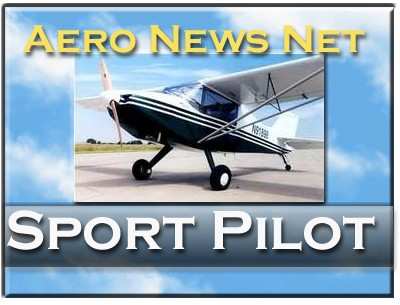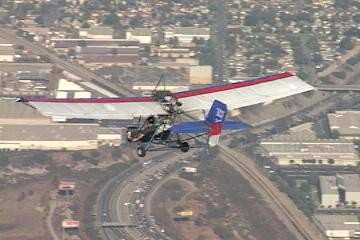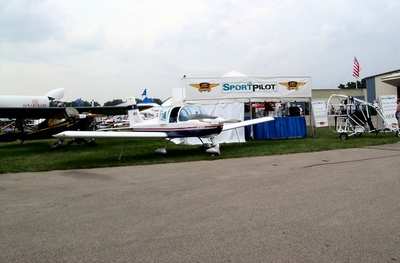Brian Carpenter Goes To School
By Jon Thornburgh
The FAA Sport Pilot initiative became effective on September 1,
2004. Throughout 2005 many provisions of the Sport Pilot rule will
be implemented, such as developing the criteria for aircraft
factories to manufacture sport aircraft, and the publication of the
"Practical Test Standards" that sport pilot applicants must meet in
order to pass their flight tests.

There is also a need for Sport Pilot Examiners (SPE), and the FAA
recently began the process of creating them. Brian Carpenter was
selected by the FAA to attend the first Sport Pilot Examiner class,
held in Sebring, Florida, from January 17th to the 24th.
Brian and his wife Carol own Rainbow Aircraft in Corning, CA. Brian
is an FAA commercial pilot and flight instructor, as well as an
ultralight instructor. His is also an A&P aircraft mechanic
with an Inspection Authorization. Carol is a private pilot, an
ultralight instructor, an FAA advanced ground instructor, and
manages the daily operation at the FBO and flight school.
Brian sent the FAA his Examiner application at the end of 2004. On
December 10th he received a letter from the FAA inviting him to
take the Sport Pilot Examiner test as the next step in the
certification process. The FAA specified that the deadline for
taking the test was December 17th. Unfortunately the letter did not
indicate what material Brian should study in order to prepare for
the test.
Carol started calling FAA officials in order to find out more about
the test. She learned that the test was available on the FAA web
site at . The test is titled "Sport Pilot Instructor/Examiner
Airman Knowledge Test Question Bank," and can be downloaded. It
consists of 464 questions, and requires 60 pages when printed out
on a computer. However, the FAA does not supply the answers to the
questions. Through diligent research, Carol found out that the
Examiner test questions were similar to the 2005 Certified Flight
Instructor test questions. Carol obtained a Gleim compact disk
containing the questions and answers, which Brian had only a few
days to study.
Brian called the "CATS" computerized test center at Chico Aviation,
about 30 miles away, in order to make an appointment to take the
test. It was then that Brian learned what it's like for an aviation
pioneer to be the first to participate in a new FAA endeavor. The
CATS center told Brian that they didn't have the Sport Pilot
Examiner test available. Carol had to make more phone calls to the
FAA in order to arrange for CATS to obtain the Examiner test
electronically. However, the handout material had to be sent to the
center by overnight Federal Express.
In spite of the delays and confusion, Brian was able to take the
test on December 15th, only two days before the deadline. He
received an outstanding score of 96%, especially remarkable
considering the lack of time to study. Carol had to FedEx the test
result to the FAA in order to meet the December 17th deadline.

On December 21st Brian received a telephone call from John
Riffey of the FAA AFS610 Branch. John congratulated Brian on
passing the Examiner test and told him that he had been selected to
attend the first Sport Pilot Examiner seminar. Shortly thereafter
Brian received a package from the FAA which explained more about
the upcoming seminar. It suggested that Brian study the Sport Pilot
Practical Test Standards guide and the Sport Pilot Examiner's
Handbook, both available on the FAA website. It also included nice
features, such as MapQuest directions to the Chateau Elan hotel in
Sebring, where the seminar would be conducted.
Carol made the hotel and airline reservations. Unfortunately, the
Chateau Elan was booked up, so Carol had to make reservations at
the Kenilworth Lodge, about 6 miles from the seminar site.
Saturday, January 15th was a long day. Carol and Brian drove from
Corning to Sacramento, boarded a United Airlines flight to Chicago,
made connections to Tampa, rented a car, and drove an hour and a
half to Sebring. They had a day to rest on Sunday, and Brian
started the first day of his seminar on Monday.
The seminar was held in a conference room in the Chateau Elan.
There were eight students and five FAA instructors, lead by Marty
Weaver, Manager of the FAA's Light Sport Aircraft Branch. Including
Brian, the students consisted of two trike pilots, two powered
parachute pilots, and four airplane pilots.
The weightshift control (trike) pilots were John Beaman from
Portland, Oregon, and Eric Johnson from Chandler, Arizona.
The powered parachute pilots were Roy Beisswenger from Greenville,
Illinois, and Larry Littlefield from Boynton Beach, Florida.
The airplane pilots were William Bardin from Sacramento,
California, Bob Bleadon from Selma, Oregon, Brian Carpenter from
Corning, California, and Romke Sikkema from Sebring, Florida.
The FAA instructors were Mark Aldridge, Larry Clymer, Tom Eldridge,
Bob Hlubin, and Marty Weaver
The first day of class consisted of an orientation and overview of
the upcoming week, along with a Power Point presentation of
regulations and Examiner's duties. Much to Brian's surprise, he
learned that he would undergo an oral exam the very next day and a
flight test on Wednesday. Brian was scheduled to take his flight
test in a Maxair Drifter, which he had never flown before.
The Drifter is owned by Lockwood Aviation, which is located on the
Sebring airfield, next to the Chateau Elan. One of the students in
the Examiner class, Romke Sikkema, is an instructor at Lockwood
Aviation. Brian arranged for a flight demonstration in the Drifter
with Romke. Brian flew about a half an hour with Romke on Tuesday
afternoon, following his oral exam earlier in the day.

It's interesting to note that the FAA did not provide the
aircraft without charge. The cost to fly the Drifter was $90 per
hour. Later in the week Brian flew a CT2K, which cost $110 per
hour. Airplane enthusiasts might also be surprised to learn that
the seminar itself is not free. The FAA charges $150 to attend the
Examiner's course. For those readers who aspire to be Examiners, be
aware that there is a substantial financial outlay to the meet your
goal, if you factor in the transportation cost to the seminar, the
rental car, hotel, meals, knowledge test, cost of study material,
the course fee and airplane rental.
Future Sport Pilot Examiners will have to consider these costs in
order to determine how much to charge pilot applicants for their
practical tests. It is expected that Sport Pilot Examiners will
charge several hundreds of dollars for each practical test. They
are only allowed to administer a maximum of two tests per day, so
their income will be limited in that respect. An Examiner's
authorization is only valid for one year, and must be renewed
annually.
Since the Examiner class consisted of weightshift, powered
parachute, and fixed wing pilots, the FAA was required to provide
all three types of aircraft for the students to take their flight
tests. The problem was that the aircraft had to be "N"-numbered,
light-sport aircraft -- not ultralights. The week prior to the
examiner's seminar there was a flurry of activity at Sebring, while
the FAA transformed trikes, powered parachutes, the Drifter and the
CT2K into Experimental Light-Sport Aircraft (LSA.) These aircraft
thus became the first ultralights to transition into LSA.
The first LSA powered parachute was a Powarchute, and the first
weight-shift LSA was an Air Creation trike.
On Tuesday, the first half of the day was devoted to class-room
exercises and preparation for the oral quiz that the Examiner
applicants would take in the afternoon. The oral exam was similar
to the test that a CFI applicant would take to initially become an
FAA instructor.
The FAA personnel administering the oral exam were Mark Aldridge
and Bob Hlubin. Each SPE applicant was asked different questions
and requested to teach a specific subject to Mark or Bob, who acted
as if they were inexperienced flight students. In Brian's case, he
was asked to demonstrate how he would teach landings to a new
student. Brian emphasized the low mass, high lift/high drag
characteristics of ultralights, which result in landing
idiosyncrasies different from conventional general aviation
aircraft.
Brian passed his oral exam and flight test with "flying" colors.
Now that the FAA had determined that Brian and the other applicants
knew how to fly and how to instruct, they would next learn how to
examine. The agenda for the next several days included lectures on
how to use the Examiner's Handbook, how to scrutinize the student's
application and logbook, how to administer the practical test, and
how to fill out the necessary paper-work to send to the FAA. An
interesting sideline is that the FAA eventually plans to use the
Internet so that Examiners can send the results of the practical
test via computer.
At the end of the course the DPE students were required to create a
"Plan of Action," which is an outline of the sequence of tasks that
an applicant must accomplish during the practical test. ("Practical
test" is the FAA's terminology for the combined oral exam and
flight test.) The Plan of Action needs to be thorough and logical.
The class was advised that an excellent re-source for creating the
Plan of Action is available at the "Plans A Plenty" web site at www.planesaplenty.com.
Another re-source was the FAA's "Practical Test Standards"
handbook.
The culmination of the SPE seminar was at the end of the week, when
Brian presented his Plan of Action to Marty Weaver. Marty pretended
that he was a Sport Pilot applicant. Brian conducted a simulated
practical test, which included the oral questions and series of
flight maneuvers in the sequence dictated by the Plan of Action
that Brian had devised. Brian also completed the forms that the FAA
requires to be submitted when an applicant concludes his practical
test.
Marty Weaver pretended he was a student pilot during the flight
test portion of the simulated practical test. Brian and Marty flew
a Flight Design CT2K, provided by Lockwood Aviation. The day before
the flight with Marty, Brian checked out in the CT2K with Romke
Sikkema.
Brian stated that the entire seminar was very well presented by the
FAA. The instructors were personable, and willing to accept
suggestions for possible changes in the future. The SPE students
must absorb a great deal of material in a short time. On some days
the classes extended from seven o'clock in the morning until seven
in the evening.

Although Carol was not permitted to attend the classes with Brian,
she took photos of the students and instructors, helped Brian
calculate his total flight time by adding up his various logbooks,
and participated in the creation of the Plan of Action.
She and Brian returned to their home in Corning via Tampa, Chicago,
and Sacramento on United Airlines. They are now back at Rainbow
Aviation, where Brian is fully prepared to administer the first
practical test to a Sport Pilot applicant. He even has a supply of
student pilot certificates for aspiring pilots who want to begin
their training.
(Jon Thornburgh is an FAA CFI, an ultralight examiner and a
welcome ANN contributor)
 ANN's Daily Aero-Term (04.14.24): Maximum Authorized Altitude
ANN's Daily Aero-Term (04.14.24): Maximum Authorized Altitude ANN's Daily Aero-Linx (04.14.24)
ANN's Daily Aero-Linx (04.14.24) Classic Aero-TV: 'We're Surviving'-- Kyle Franklin Describes Airshow Life 2013
Classic Aero-TV: 'We're Surviving'-- Kyle Franklin Describes Airshow Life 2013 Aero-News: Quote of the Day (04.14.24)
Aero-News: Quote of the Day (04.14.24) Airborne 04.09.24: SnF24!, Piper-DeltaHawk!, Fisher Update, Junkers
Airborne 04.09.24: SnF24!, Piper-DeltaHawk!, Fisher Update, Junkers






